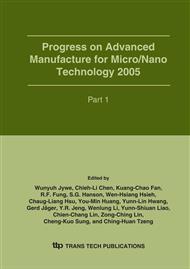p.331
p.337
p.343
p.349
p.355
p.361
p.367
p.373
p.379
An Investigation on the Application of Cryogenic Ball Milling to Ibuprofen Particle and Its Characteristics
Abstract:
For a present study, a cryogenic ball milling process was applied to reduce the Ibuprofen particles to submicron in order to enlarge their dissolution rate. The cryogenic ball milling was performed using 6 mm zirconia balls at a temperature of -180 °C or lower. The effects of milling time, the weight ratio of ball to Ibuprofen, and milling speed on the particle size were investigated. SEM and particle size analyzer were used to analyze the shape and size of particles before and after ball milling. The chemical changes before and after the cryogenic ball milling process were examined through XRD (x-ray diffraction) analysis. The results show that the size of Ibuprofen particles was reduced to about 1/20 of its initial size and the particle size showed negligible change after six hours of ball milling. The effect of weight ratio and the milling speed on the particle size was almost negligible. The results also show that cryogenic ball milling yielded no chemical changes in the particle.
Info:
Periodical:
Pages:
355-360
Citation:
Online since:
January 2006
Authors:
Keywords:
Price:
Сopyright:
© 2006 Trans Tech Publications Ltd. All Rights Reserved
Share:
Citation:


